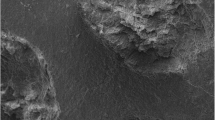Abstract
Porcelain laminate veneers as esthetic and minimally invasive restorations are being used as an alternative to full veneer crowns. However, the removal of porcelain veneers that have failed may be an uncomfortable and time-consuming procedure because of the high bond strength between the porcelain laminate veneers and the tooth surface. The purpose of this study was to prepare a simple and reliable method for porcelain laminate veneer debonding by using an Er:YAG laser with the scanning method and to determine the amount of lasing time required. Eighty cylindrical specimens with a thickness of 0.7 mm and a diameter of 5 mm were fabricated from Empress II ceramic material. They were cemented on the labial surface of extracted bovine mandibular incisors using Variolink II (Ivoclar Vivadent AG, Schaan, Liechtenstein) and light cured for 40 s. The specimens were randomly divided into four groups of 20. The first group was assigned as the control group and no laser application was performed. The Er:YAG laser was applied on each specimen in the other three study groups for 3, 6, and 9 s by using the scanning method. One second after the lasing, a mechanical force was applied to remove the laminate veneers by using an Instron Universal Testing machine. Results of this study exhibited statistically significant differences between the control group and the three study groups. Intergroup comparison of shear bond strengths of the three study groups showed a statistically significant difference (p = 0.0001). This study showed that all three application times of Er-YAG laser were effective for debonding ceramic laminate veneers by softening the adhesive resin.

Similar content being viewed by others
References
Shaini FJ, Shortall AC, Marquis PM (1997) Clinical performance of porcelain laminate veneers. A retrospective evaluation over a period of 6.5 years. J Oral Rehabil 24:553–559
Dunne SM, Millar BJ (1993) A longitudinal study of the clinical performance of porcelain veneers. Br Dent J 175:317–321
McCullock AJ (1992) Dental demolition. Dent Update 19:255–262
Tocchio RM, Williams PT, Mayer FS, Standing KG (1993) Laser debonding of ceramic orthodontic brackets. Am J Orthod Dentofac Orthop 103:155–162
Strobl K, Bahns TL, Willham L, Bishara SE, Stwalley WC (1992) Laser-aided debonding of orthodontic ceramic brackets. Am J Orthod Dentofac Orthop 101:152–158
Obata A, Tsumura T, Niwa K, Ashizawa Y, Deguchi T, Ito M (1999) Super pulse CO2 laser for bracket bonding and debonding. Eur J Orthod 21:193–198
Oztoprak MO, Nalbantgil D, Erdem AS, Tozlu M, Arun T (2010) Debonding of ceramic brackets by a new scanning laser method. Am J Orthod Dentofac Orthop 138:195–200
Nalbantgil D, Oztoprak MO, Tozlu M, Arun T (2010) Effects of different application durations of ER:YAG laser on intrapulpal temperature change during debonding. Lasers Med Sci. doi:10.1007/s10103-010-0796-7
Dostalova T, Jelinkova H, Sulc J, Nemec M, Jelinek M, Fibrich M, Michalik P, Miyagi M, Seydlova M (2011) Ceramic bracket debonding by Tm:YAP laser irradiation. Photomed Laser Surg 29:477–484
Feldon PJ, Murray PE, Burch JG, Meister M, Freedmand MA (2010) Diode laser debonding of ceramic brackets. Am J Orthod Dentofac Orthop 138:458–462
Tehranchi A, Fekrazad R, Zafar M, Eslami B, Kalhori KM, Gutknecht N (2010) Evaluation of the effects of CO2 laser on debonding of orthodontics porcelain brackets vs. the conventional method. Lasers Med Sci. doi:10.1007/s10103-010-0820-y
Sarp AS, Gülsoy M (2010) Ceramic bracket debonding with ytterbium fiber laser. Lasers Med Sci. doi:10.1007/s10103-010-0817-6
Nakamichi I, Iwaku M, Fusayama T (1983) Bovine teeth as possible substitutes in the adhesion test. J Dent Res 62:1076–1081
Smith HZ, Casko JS, Leinfelder KF, Utley JD (1976) Comparison of orthodontic bracket bond strengths: human vs bovine enamel. J Dent Res 55:B-153, Abstr. 367
Strassler HE, Nathanson D (1989) Clinical evaluation of etched porcelain veneers over a period of 18 to 42 months. J Esthet Dent 1:21–28
Kihn PW, Barnes DM (1998) The clinical evaluation of porcelain veneers: a 48-month clinical evaluation. JADA 129:747–752
Calamia JR (1989) Clinical evaluation of etched porcelain veneers. Am J Dent 2:9–15
Stacey GD (1993) A shear stress analysis of the bonding of porcelain veneers to enamel. J Prosthet Dent 70:395–402
Wigdor H, Abt E, Ashrafi S, Walsh JT (1993) The effect of lasers on dental hard tissues. J Am Dent Assoc 124:65–70
Mehl A, Kremers L, Salzmann K, Hickel R (1997) 3D volume-ablation rate and thermal side effects with the Er:YAG and Nd:YAG laser. Dent Mater 13:246–251
Chirila TV, Constable IJ, van Saarloos PP, Barrett GD (1990) Laser-induced damage to transparent polymers: chemical effect of short-pulsed (Q-switched) Nd:YAG laser radiation on ophthalmic acrylic biomaterials: I: a review. Biomater 11:305–312
Author information
Authors and Affiliations
Corresponding author
Rights and permissions
About this article
Cite this article
Oztoprak, M.O., Tozlu, M., Iseri, U. et al. Effects of different application durations of scanning laser method on debonding strength of laminate veneers. Lasers Med Sci 27, 713–716 (2012). https://doi.org/10.1007/s10103-011-0959-1
Received:
Accepted:
Published:
Issue Date:
DOI: https://doi.org/10.1007/s10103-011-0959-1




